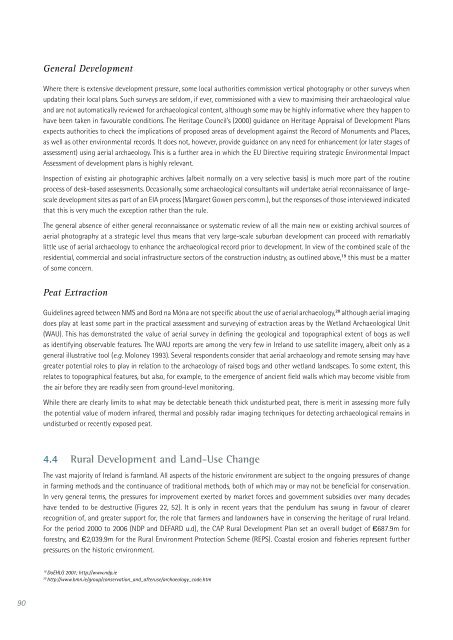Aerial Archaeology in Ireland - The Heritage Council
Aerial Archaeology in Ireland - The Heritage Council
Aerial Archaeology in Ireland - The Heritage Council
You also want an ePaper? Increase the reach of your titles
YUMPU automatically turns print PDFs into web optimized ePapers that Google loves.
90<br />
General Development<br />
Where there is extensive development pressure, some local authorities commission vertical photography or other surveys when<br />
updat<strong>in</strong>g their local plans. Such surveys are seldom, if ever, commissioned with a view to maximis<strong>in</strong>g their archaeological value<br />
and are not automatically reviewed for archaeological content, although some may be highly <strong>in</strong>formative where they happen to<br />
have been taken <strong>in</strong> favourable conditions. <strong>The</strong> <strong>Heritage</strong> <strong>Council</strong>’s (2000) guidance on <strong>Heritage</strong> Appraisal of Development Plans<br />
expects authorities to check the implications of proposed areas of development aga<strong>in</strong>st the Record of Monuments and Places,<br />
as well as other environmental records. It does not, however, provide guidance on any need for enhancement (or later stages of<br />
assessment) us<strong>in</strong>g aerial archaeology. This is a further area <strong>in</strong> which the EU Directive requir<strong>in</strong>g strategic Environmental Impact<br />
Assessment of development plans is highly relevant.<br />
Inspection of exist<strong>in</strong>g air photographic archives (albeit normally on a very selective basis) is much more part of the rout<strong>in</strong>e<br />
process of desk-based assessments. Occasionally, some archaeological consultants will undertake aerial reconnaissance of largescale<br />
development sites as part of an EIA process (Margaret Gowen pers comm.), but the responses of those <strong>in</strong>terviewed <strong>in</strong>dicated<br />
that this is very much the exception rather than the rule.<br />
<strong>The</strong> general absence of either general reconnaissance or systematic review of all the ma<strong>in</strong> new or exist<strong>in</strong>g archival sources of<br />
aerial photography at a strategic level thus means that very large-scale suburban development can proceed with remarkably<br />
little use of aerial archaeology to enhance the archaeological record prior to development. In view of the comb<strong>in</strong>ed scale of the<br />
residential, commercial and social <strong>in</strong>frastructure sectors of the construction <strong>in</strong>dustry, as outl<strong>in</strong>ed above, 19 this must be a matter<br />
of some concern.<br />
Peat Extraction<br />
Guidel<strong>in</strong>es agreed between NMS and Bord na Móna are not specific about the use of aerial archaeology, 20 although aerial imag<strong>in</strong>g<br />
does play at least some part <strong>in</strong> the practical assessment and survey<strong>in</strong>g of extraction areas by the Wetland Archaeological Unit<br />
(WAU). This has demonstrated the value of aerial survey <strong>in</strong> def<strong>in</strong><strong>in</strong>g the geological and topographical extent of bogs as well<br />
as identify<strong>in</strong>g observable features. <strong>The</strong> WAU reports are among the very few <strong>in</strong> <strong>Ireland</strong> to use satellite imagery, albeit only as a<br />
general illustrative tool (e.g. Moloney 1993). Several respondents consider that aerial archaeology and remote sens<strong>in</strong>g may have<br />
greater potential roles to play <strong>in</strong> relation to the archaeology of raised bogs and other wetland landscapes. To some extent, this<br />
relates to topographical features, but also, for example, to the emergence of ancient field walls which may become visible from<br />
the air before they are readily seen from ground-level monitor<strong>in</strong>g.<br />
While there are clearly limits to what may be detectable beneath thick undisturbed peat, there is merit <strong>in</strong> assess<strong>in</strong>g more fully<br />
the potential value of modern <strong>in</strong>frared, thermal and possibly radar imag<strong>in</strong>g techniques for detect<strong>in</strong>g archaeological rema<strong>in</strong>s <strong>in</strong><br />
undisturbed or recently exposed peat.<br />
4.4 Rural Development and Land-Use Change<br />
<strong>The</strong> vast majority of <strong>Ireland</strong> is farmland. All aspects of the historic environment are subject to the ongo<strong>in</strong>g pressures of change<br />
<strong>in</strong> farm<strong>in</strong>g methods and the cont<strong>in</strong>uance of traditional methods, both of which may or may not be beneficial for conservation.<br />
In very general terms, the pressures for improvement exerted by market forces and government subsidies over many decades<br />
have tended to be destructive (Figures 22, 52). It is only <strong>in</strong> recent years that the pendulum has swung <strong>in</strong> favour of clearer<br />
recognition of, and greater support for, the role that farmers and landowners have <strong>in</strong> conserv<strong>in</strong>g the heritage of rural <strong>Ireland</strong>.<br />
For the period 2000 to 2006 (NDP and DEFARD u.d), the CAP Rural Development Plan set an overall budget of €687.9m for<br />
forestry, and €2,039.9m for the Rural Environment Protection Scheme (REPS). Coastal erosion and fisheries represent further<br />
pressures on the historic environment.<br />
19 DoEHLG 2001; http://www.ndp.ie<br />
20 http://www.bmn.ie/group/conservation_and_afteruse/archaeology_code.htm

















